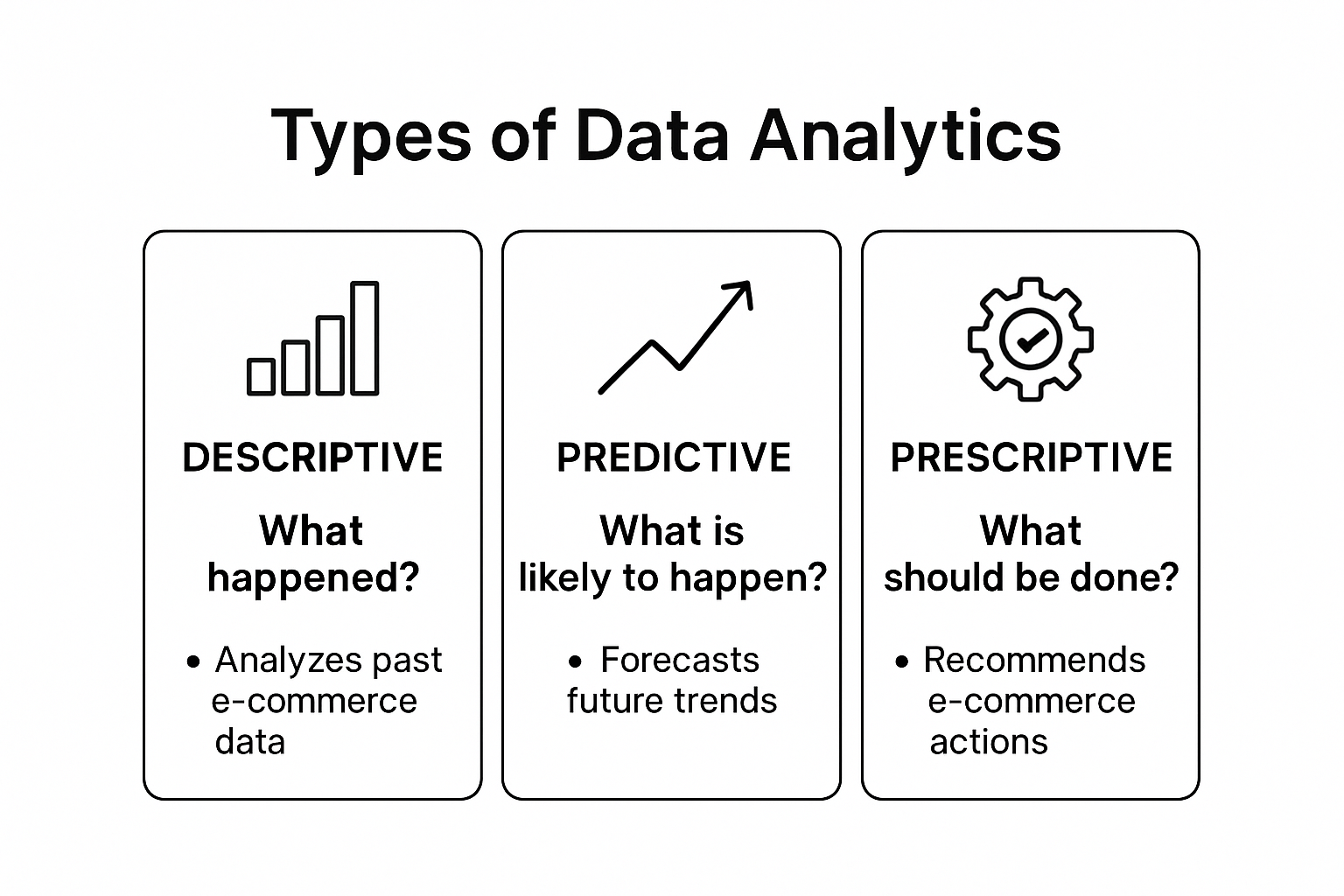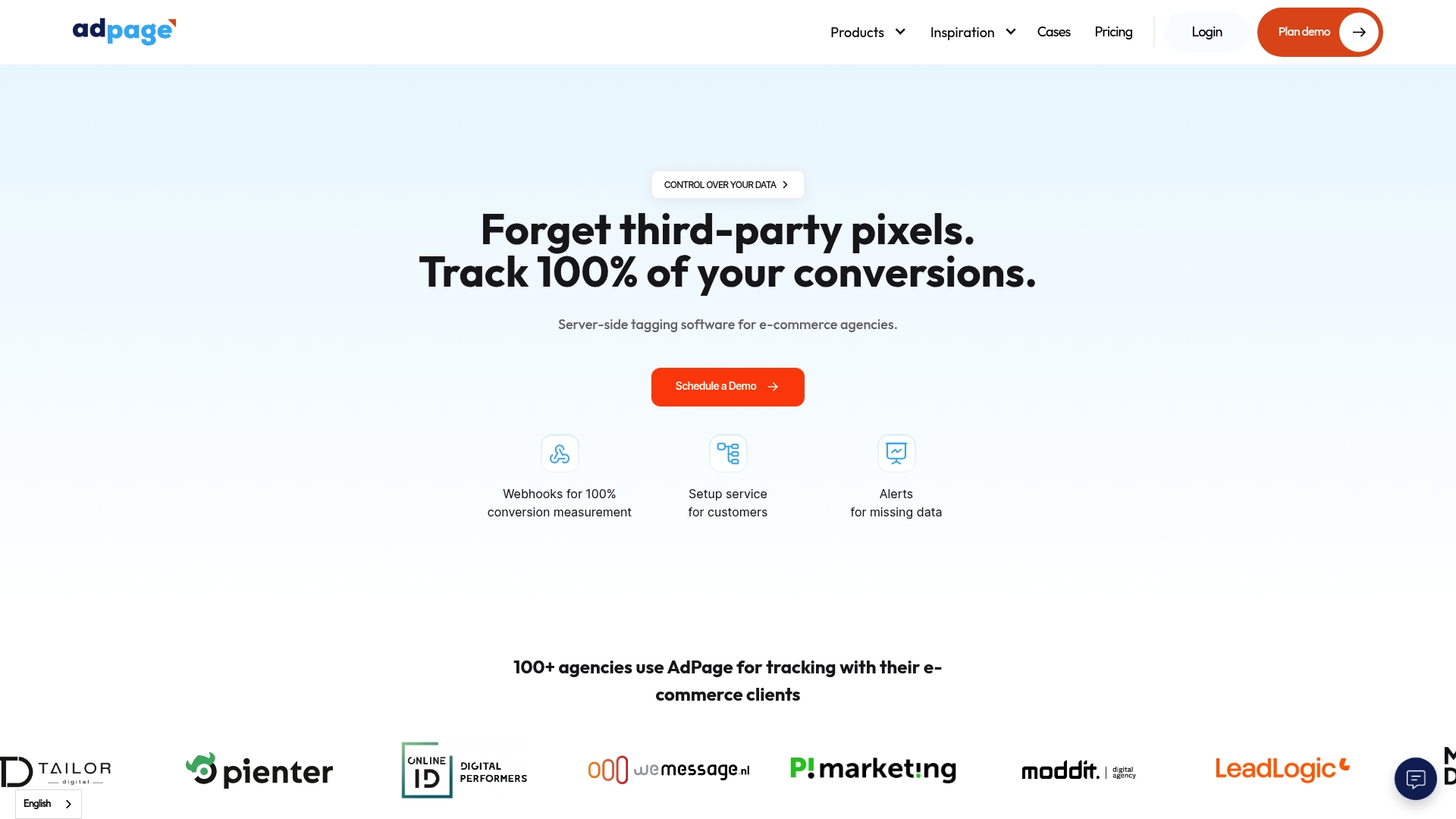Data analytics is reshaping how e-commerce businesses win customers and stay ahead of the curve. Shoppers generate mountains of data every second yet most businesses only tap into half its potential. Here is the shocker. Companies using predictive analytics can see revenue rise by up to 20 percent. Those who master the right analytics types in 2025 will not only predict trends but make smarter decisions before the competition even notices.
Table of Contents
- Understanding The Main Types Of Data Analytics
- How Each Analytics Type Impacts E-commerce
- Choosing The Right Analytics Approach For Your Business
- Best Practices To Integrate Data Analytics In 2025.
Quick Summary
| Takeaway | Explanation |
|---|---|
| Descriptive Analytics is Essential | Provides foundational insights into historical data, enabling e-commerce businesses to understand customer behaviors and improve operational efficiency by up to 25%. |
| Predictive Analytics Drives Anticipation | Utilizes historical data to forecast future trends, helping businesses anticipate demand and mitigate risks, potentially increasing revenue by 10-20%. |
| Prescriptive Analytics Offers Strategic Recommendations | Combines insights from descriptive and predictive analytics to recommend optimal actions, enhancing decision-making efficiency by up to 40%. |
| Invest in Data Infrastructure | Establishing a robust data infrastructure is crucial for seamless data integration and advanced analytics capabilities, ensuring long-term success. |
| Cultivate a Data-Driven Culture | Fostering an environment where analytical insights are leveraged across all levels ensures businesses can respond effectively to market dynamics. |
Understanding the Main Types of Data Analytics
Data analytics has become the cornerstone of strategic decision-making for e-commerce businesses seeking to gain a competitive edge. As digital marketplaces become increasingly complex, understanding the various types of data analytics provides organizations with powerful insights that can transform raw information into actionable business strategies.

Descriptive Analytics: Unveiling Historical Patterns
Descriptive analytics serves as the foundational layer of data analysis, offering a comprehensive look into past performance and historical trends. By examining accumulated data, businesses can uncover critical insights about customer behaviors, sales patterns, and operational effectiveness. Research from Gartner suggests that approximately 80% of business intelligence relies on descriptive analytics to understand what has already occurred.
In the e-commerce context, descriptive analytics might reveal crucial information such as:
- Purchase Frequencies: Understanding how often customers make transactions
- Seasonal Trends: Identifying peak buying periods and seasonal variations
- Customer Segmentation: Categorizing customers based on demographic and behavioral characteristics

Predictive Analytics: Forecasting Future Opportunities
While descriptive analytics looks backward, predictive analytics enables businesses to anticipate future trends and potential outcomes. By leveraging advanced statistical models and machine learning algorithms, organisations can develop sophisticated forecasting capabilities. According to IBM, predictive analytics transforms historical data into probabilistic models that help businesses make more informed decisions.
Key applications in e-commerce include:
- Customer Lifetime Value Prediction: Estimating the potential long-term value of individual customers
- Demand Forecasting: Anticipating product demand and optimizing inventory management
- Churn Prevention: Identifying customers likely to discontinue their engagement
Prescriptive Analytics: Driving Strategic Recommendations
Prescriptive analytics represents the most advanced stage of data analysis, moving beyond observation and prediction to provide specific strategic recommendations. This approach combines insights from descriptive and predictive analytics to suggest optimal courses of action. Research from McKinsey indicates that organizations implementing prescriptive analytics can experience up to a 20% improvement in strategic decision-making.
In the e-commerce landscape, prescriptive analytics can help businesses:
- Personalize Marketing Strategies: Develop targeted campaigns based on individual customer preferences
- Pricing Optimization: Recommend dynamic pricing strategies
- Product Recommendation Engines: Create intelligent suggestion systems that enhance customer experience
Understanding these types of data analytics provides e-commerce businesses with a comprehensive toolkit for transforming raw data into strategic insights. By integrating descriptive, predictive, and prescriptive approaches, organizations can develop a nuanced understanding of their market, customers, and potential opportunities.
To help clarify the distinctions and key features of each type of data analytics, the following table provides a comparison summarizing their purpose, typical applications, and example benefits in the e-commerce context.
| Analytics Type | Purpose | E-commerce Applications | Example Benefit |
|---|---|---|---|
| Descriptive | Analyze past data to understand patterns | Sales tracking, customer segmentation | Improves operational efficiency by 25% |
| Predictive | Forecast outcomes and trends | Demand forecasting, churn prevention | Increases revenue by 10-20% |
| Prescriptive | Recommend optimum actions | Dynamic pricing, personalized marketing | Improves decision efficiency by up to 40% |
How Each Analytics Type Impacts E-commerce
In the rapidly evolving digital marketplace, data analytics has become a transformative force for e-commerce businesses, offering unprecedented insights and strategic capabilities. Each type of data analytics delivers unique value, enabling organizations to make more informed, data-driven decisions that directly impact performance and competitive positioning.
Descriptive Analytics: Revealing Performance Foundations
Descriptive analytics provides the critical groundwork for understanding an e-commerce business's current state. Research from Deloitte reveals that companies leveraging descriptive analytics can improve operational efficiency by up to 25%. By systematically examining historical data, businesses gain insights into key performance metrics such as conversion rates, customer acquisition costs, and revenue streams.
Specific impacts include:
- Comprehensive Performance Mapping: Creating detailed visualizations of sales trajectories
- Revenue Stream Analysis: Understanding which product categories generate maximum returns
- Customer Behaviour Tracking: Identifying purchasing patterns and engagement trends
Predictive Analytics: Anticipating Market Dynamics
Predictive analytics transforms historical data into forward-looking intelligence, enabling businesses to proactively respond to emerging market trends. According to research by Forrester, organizations implementing predictive models can achieve a 10-20% increase in potential revenue through targeted interventions.
Key strategic advantages encompass:
- Demand Forecasting: Accurately predicting product popularity and inventory requirements
- Customer Lifetime Value Estimation: identifying high-potential customer segments
- Risk Mitigation: Anticipating potential market disruptions and customer churn
Prescriptive Analytics: Generating Actionable Strategies
Prescriptive analytics represents the pinnacle of data-driven decision-making, offering precise recommendations that drive strategic improvements. McKinsey research indicates that businesses implementing prescriptive analytics can experience up to a 40% improvement in strategic planning efficiency.
Critical applications include:
- Dynamic Pricing Strategies: Recommending optimal pricing models based on real-time market conditions
- Personalized Marketing Interventions: Designing targeted campaigns with maximum conversion potential
- Operational Optimization: Suggesting workflow improvements and resource allocation
By integrating these three analytical approaches, e-commerce businesses can develop a comprehensive understanding of their operational landscape. Each analytics type builds upon the previous, creating a sophisticated ecosystem of insights that transforms raw data into strategic advantage. The future of e-commerce success lies not just in collecting data, but in extracting meaningful, actionable intelligence that drives sustainable growth and competitive differentiation.
Below is a summary table outlining the main impacts and benefits each analytics type delivers for e-commerce businesses as discussed above.
| Analytics Type | Main Impact | Typical Benefits |
|---|---|---|
| Descriptive | Reveals performance foundations | Enhances operational efficiency (up to 25%) |
| Predictive | Anticipates market and customer trends | Increases revenue (10-20%), reduces risk |
| Prescriptive | Generates strategic, actionable recommendations | Boosts strategic decision efficiency (up to 40%) |
Choosing the Right Analytics Approach for Your Business
Selecting the appropriate data analytics strategy is crucial for e-commerce businesses seeking to maximize their competitive advantage. The complexity of choosing the right approach requires a nuanced understanding of your organization's unique objectives, technological capabilities, and strategic goals.
Assessing Organizational Readiness and Data Maturity.
Before implementing any data analytics approach, businesses must critically evaluate their current data infrastructure and analytical capabilities. Research from Gartner indicates that organizations with well-defined data maturity models are 3.5 times more likely to achieve successful analytics implementations.
Key considerations include:
- Data Quality: Evaluating the completeness and accuracy of existing data sources
- Technological Infrastructure: Assessing current analytics tools and integration capabilities
- Skill Set Availability: Determining internal expertise in data analysis and interpretation
Matching Analytics Approaches to Business Objectives
Different business challenges require specific analytical approaches. McKinsey research suggests that organizations should align their analytics strategy with precise strategic objectives rather than adopting a one-size-fits-all methodology.
Strategic alignment involves:
- Performance Tracking: Using descriptive analytics for comprehensive performance monitoring
- Strategic Planning: Implementing predictive analytics for forward-looking decision-making
- Complex Decision Support: Leveraging prescriptive analytics for nuanced strategic recommendations
Investment and Scalability Considerations.
Implementing advanced analytics requires significant investment and long-term commitment. According to Forrester, successful organizations approach analytics as a strategic capability rather than a temporary technological intervention.
Critical investment factors include:
- Technology Infrastructure: Budgeting for advanced analytics platforms
- Talent Acquisition: Investing in skilled data professionals
- Continuous Learning: Developing ongoing training and development programs
The journey toward effective data analytics is not about implementing the most sophisticated technology, but about creating a strategic approach that aligns technological capabilities with organizational objectives. Businesses must remain flexible, continuously evaluate their analytics strategies, and be prepared to adapt as market dynamics and technological capabilities evolve.
Ultimately, the most successful e-commerce organizations will be those that view data analytics not as a standalone function, but as an integrated approach to understanding and responding to complex market dynamics. By carefully selecting and implementing the right analytics approach, businesses can transform raw data into a powerful strategic asset that drives innovation, efficiency, and sustainable growth.
Best Practices to Integrate Data Analytics in 2025.
As e-commerce continues to evolve, integrating data analytics effectively becomes increasingly critical for businesses seeking sustainable growth and competitive advantage. The landscape of data analytics in 2025 demands a sophisticated, strategic approach that goes beyond traditional analytical methodologies.
Establishing a Robust Data Infrastructure.
Research from Gartner emphasizes that organizations must build a comprehensive data infrastructure that supports seamless data collection, processing, and analysis. A robust infrastructure serves as the foundation for advanced analytics capabilities, enabling businesses to transform raw data into actionable insights.
Key infrastructure considerations include:
- Cloud-Based Solutions: Implementing scalable and flexible cloud platforms
- Data Integration Tools: Ensuring smooth connectivity between multiple data sources
- Advanced Security Protocols: Protecting sensitive customer and business information
Implementing Ethical and Compliant Analytics Frameworks.
With increasing regulatory scrutiny, e-commerce businesses must prioritize ethical data practices and compliance. According to the European Data Protection Board, organizations must develop transparent analytics frameworks that respect user privacy and maintain stringent data protection standards.
Critical ethical considerations include:
- Transparent Data Collection: Clearly communicating data usage policies
- User Consent Management: Implementing robust consent mechanisms
- Algorithmic Fairness: Ensuring analytics models do not introduce unintended biases
Developing a Data-Driven Organizational Culture.
McKinsey research highlights that successful data analytics integration requires more than technological investment. Organizations must cultivate a data-driven culture that empowers employees to leverage analytical insights across all operational levels.
Strategies for cultural transformation include:
- Continuous Learning Programs: Investing in data literacy training
- Cross-Functional Collaboration: Breaking down departmental silos
- Leadership Commitment: Ensuring executive support for data-driven decision-making
The future of e-commerce analytics extends beyond mere data collection. Businesses must view data as a strategic asset, creating dynamic, adaptable systems that can rapidly respond to changing market conditions. By embracing comprehensive infrastructure, ethical frameworks, and a progressive organizational culture, e-commerce businesses can unlock unprecedented insights and drive meaningful innovation.
Successful integration of data analytics in 2025 will be characterized by organizations that can seamlessly blend technological capability with strategic vision. Those who master this delicate balance will not just survive but thrive in an increasingly complex digital marketplace.
Frequently Asked Questions
What are the main types of data analytics used in e-commerce?
The main types of data analytics in e-commerce include descriptive analytics, predictive analytics, and prescriptive analytics. Each type serves different purposes, from understanding historical data to forecasting future trends and recommending optimal strategies.
How can descriptive analytics benefit my e-commerce business?
Descriptive analytics provides insights into historical performance and customer behaviors. By analyzing past data, businesses can improve operational efficiency by up to 25% and better understand their customer base, helping to inform future business strategies.
What advantages does predictive analytics offer for e-commerce?
Predictive analytics allows e-commerce businesses to forecast future trends and customer behaviors. This capability can lead to a potential revenue increase of 10-20% by enabling companies to anticipate market demand, optimize inventory, and reduce customer churn.
How does prescriptive analytics improve decision-making in e-commerce?
Prescriptive analytics combines insights from descriptive and predictive analytics to offer specific recommendations for action. This advanced analysis can enhance decision-making efficiency by up to 40%, enabling businesses to make smarter strategic choices for marketing, pricing, and product recommendations.
Unleash the Real Power of Your E-commerce Data in 2025
Are you frustrated by lost conversions and outdated tracking methods holding your business back? This article explains how predictive and prescriptive analytics can drive e-commerce success, but if your data collection is incomplete or inaccurate, you may never unlock these benefits. Many businesses struggle with missing data, reduced visibility into customer journeys, and uncertainty about compliance. Moving beyond basic analytics is essential for anyone serious about staying ahead in competitive digital markets.

With AdPage, you gain access to server-side tagging, robust consent management, and the ability to track every single conversion accurately. Our tools are designed for marketers who want to convert insights into action, improve reporting, and operate with total GDPR confidence. If your current analytics platform misses key signals or fails to provide a holistic view, now is the moment to upgrade. Visit our homepage to discover how our seamless integrations can transform your tracking, strengthen your analytics, and help you overcome the limitations highlighted in this article. Take the lead in 2025 and drive measurable growth with AdPage.



.png)
